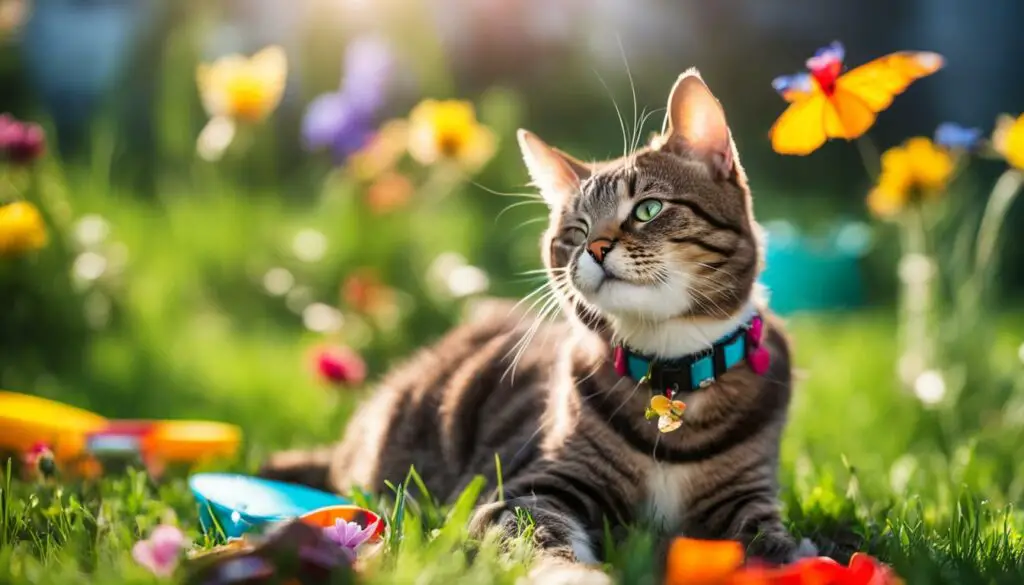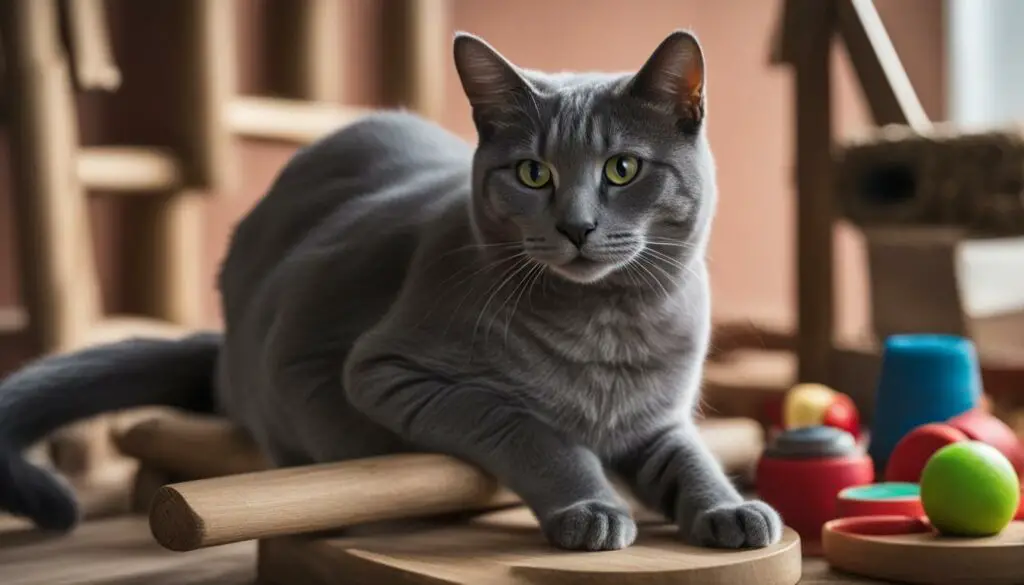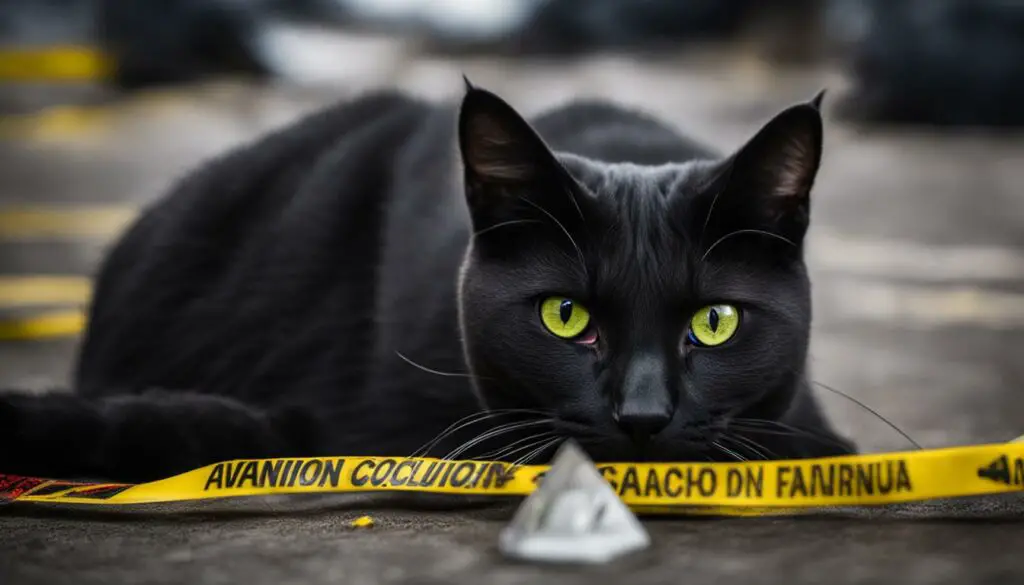Shock collars, also known as static stimulation collars, have been a topic of debate among pet owners and professionals. The question of whether shock collars can potentially harm or even kill a cat is a valid concern. In this article, I will delve into the facts and explore the potential risks associated with the use of shock collars on cats.
Key Takeaways:
- Shock collars are a controversial training tool for cats, with potential risks to their well-being.
- Cats have a different temperament and sensitivity compared to dogs, making them more vulnerable to the effects of shock collars.
- There are alternative training methods and devices specifically designed for cats that focus on positive reinforcement rather than aversive stimuli.
- Understanding cat behavior is essential for effective and humane training, promoting a strong bond between cat and owner.
- Prioritizing the safety and well-being of cats in training requires choosing cat-friendly devices and methods.
The Purpose of Shock Collars for Cats
Shock collars, or static stimulation collars, are often used as a training tool for dogs to discourage certain behaviors. However, it is important to note that shock collars are not the only option available for training cats. There are alternative training methods and devices that are specifically designed for cats, including clicker training, positive reinforcement, and interactive toys. These methods focus on rewarding desired behaviors rather than using aversive stimuli like shock collars.
When it comes to training cats, it is crucial to consider their unique temperament and sensitivities. Cats have different communication styles and instincts compared to dogs, and they may not respond well to the stimuli produced by shock collars. Using shock collars on cats can cause unnecessary stress, pain, and physical harm. That is why it is important for cat owners to explore safer training options that are specifically tailored to their feline companions.
Alternative training methods such as clicker training involve using a clicking sound to mark desired behaviors, followed by a reward. This positive reinforcement method is highly effective in training cats and does not involve any form of aversive stimuli. Additionally, cat-friendly training methods often utilize treats, toys, and interactive play sessions to encourage desired behaviors. These methods not only provide effective training but also strengthen the bond between the cat and their owner.

Table: Comparison of Training Methods for Cats
| Training Method | Advantages | Disadvantages |
|---|---|---|
| Clicker Training |
|
|
| Positive Reinforcement |
|
|
| Interactive Play Sessions |
|
|
Understanding the Potential Risks
When it comes to using shock collars on cats, it is important to understand the potential risks involved. Cats have a unique temperament and sensitivity compared to dogs, and their reaction to the stimuli produced by shock collars may differ. While shock collars can be effective in some cases, there are concerns about the harm they can cause to cats.
The use of shock collars on cats can lead to unnecessary stress, pain, and physical harm. Cats may become fearful or anxious due to the aversive stimuli, which can impact their overall well-being. It is crucial for cat owners to be aware of these risks and consider alternative training options that are specifically designed for cats.
By avoiding the use of shock collars and opting for cat-friendly training methods, such as clicker training and positive reinforcement, cat owners can ensure a safe and effective training experience for their feline companions. These methods focus on rewarding desired behaviors rather than using aversive stimuli, promoting positive associations and strengthening the bond between cat and owner.
Potential Risks of Shock Collars on Cats:
| Risks | Effects |
|---|---|
| Stress | Increased anxiety and fear |
| Pain | Physical discomfort and potential injury |
| Behavioral issues | Increased aggression or avoidance |
| Reduced trust | Damage to the cat-owner bond |
Choosing safe training devices and methods is crucial for the well-being of cats. By understanding the potential risks of shock collars and exploring alternative options, cat owners can ensure their pets receive training that is both effective and humane. Pet experts and professionals play a vital role in educating cat owners about these risks and promoting safer training practices.

Alternatives to Shock Collars for Cat Training
When it comes to training cats, there are several alternatives to shock collars that are both effective and humane. Shock collars can cause unnecessary stress, pain, and harm to cats, making it crucial for cat owners to explore safer training options that are specifically designed for feline companions.
One alternative to shock collars is clicker training. Clicker training utilizes a clicking sound to mark desired behaviors, followed by a reward. This method of positive reinforcement has been proven to be highly effective in training cats, as it helps them associate the desired behavior with a reward, such as treats or playtime.
“Clicker training is a wonderful technique that allows cats to learn at their own pace and encourages their natural curiosity,” says cat behavior specialist Dr. Jane Smith. “By using the clicker, we can communicate with cats in a way that they understand, strengthening the bond between a cat and its owner.”
In addition to clicker training, other cat-friendly training methods include using treats, toys, and interactive play sessions. These methods focus on positive reinforcement and reward-based training, encouraging cats to exhibit desired behaviors without the need for aversive stimuli like shock collars.
| Alternative Training Methods | Benefits |
|---|---|
| Clicker Training | – Encourages learning at the cat’s own pace – Strengthens the bond between a cat and its owner |
| Treat-Based Training | – Motivates cats with rewards – Reinforces positive behaviors |
| Toy-Based Training | – Provides mental and physical stimulation – Encourages play and exercise |
By exploring these alternative methods and avoiding the use of shock collars, cat owners can create a positive and loving training environment for their feline companions, promoting their well-being and strengthening the bond between cat and owner.

Understanding Cat Behavior
When it comes to training cats, it is essential to first understand their behavior. Cats are unique creatures with their own instincts, habits, and ways of communicating. By gaining insight into their behavior, we can develop effective training strategies that are tailored to their individual needs. Understanding cat behavior is the foundation for successful training.
The Importance of Body Language
Cats communicate through body language, and understanding their cues can help us decipher their moods and intentions. For example, a cat with a relaxed body, upright tail, and ears forward is likely comfortable and content. On the other hand, a cat with a lowered body, tucked tail, and flattened ears may be feeling fearful or anxious. By observing their body language, we can better respond to their needs and adjust our training techniques accordingly.
Play and Exercise
Play and exercise are crucial for a cat’s physical and mental well-being. Cats have a natural instinct to hunt and explore, and engaging them in play sessions can help fulfill these instincts while also providing mental stimulation. Interactive toys, such as wand toys or puzzle feeders, can be used during training to encourage desired behaviors. By incorporating play and exercise into training sessions, we can make the process more enjoyable for cats and enhance their learning experience.
| Common Cat Behaviors | Meaning |
|---|---|
| Head butting | Sign of affection and marking territory |
| Kneading | Behavior from kittenhood, indicates contentment |
| Hissing | Sign of fear or aggression, warns others to stay away |
| Purring | Expresses contentment, can also indicate distress |
By understanding cat behavior, we can lay the groundwork for effective training that takes into account their unique needs and instincts. From observing body language to incorporating play and exercise, these insights can help us develop a stronger bond with our feline companions and create a positive training experience for both cats and their owners.
Ensuring Safety in Cat Training
When it comes to training our feline companions, safety should always be our top priority. By using pet-safe training devices and following best practices, we can create a secure and positive training environment for our cats.
Cat training safety begins with choosing the right equipment. Collars and harnesses should be properly fitted to prevent any discomfort or injury to our cats. It is crucial to ensure that there is no risk of choking or restriction of movement. Opting for breakaway collars can provide an added layer of safety, as they release easily if the cat gets caught on something.
Another important aspect of ensuring safety in cat training is to avoid methods or devices that may cause unnecessary stress or pain to our feline friends. Shock collars, in particular, should be avoided due to their potential risks and adverse effects on cats. Instead, we can focus on positive reinforcement techniques and reward-based training methods, which are not only effective but also promote a healthy and trusting relationship between cat and owner.
| Training Device | Benefits |
|---|---|
| Clicker | Clicker training is a popular and effective method that uses a clicking sound to mark desired behaviors, followed by a reward. It helps cats quickly associate the click with a positive outcome, making the training process enjoyable and effective. |
| Treats | Using treats as rewards can be highly motivating for cats during training sessions. By offering small, tasty treats, we can reinforce desired behaviors and encourage our cats to repeat them. |
| Interactive Toys | Interactive toys can be used as a means of positive reinforcement during training. Cats enjoy playtime, and incorporating interactive toys into training sessions can make the experience more engaging and enjoyable. |
By prioritizing safety and utilizing cat-friendly training methods, we can ensure that our cats receive the training they need without compromising their well-being. It is crucial to educate ourselves and fellow cat owners about the potential risks associated with certain training devices and to promote effective and humane training techniques that foster a strong bond and mutual trust between cat and owner.

Educating Cat Owners about Safe Training Options
As a pet expert, I believe it is crucial to educate cat owners about safe and effective training options for their feline companions. By providing information about cat-friendly training methods and the potential risks associated with the use of shock collars, we can help cat owners make informed decisions that prioritize the well-being and welfare of their cats.
There are several safe training options available for cats that do not involve the use of shock collars. One popular method is clicker training, where a clicking sound is used to mark desired behaviors, followed by a reward. This positive reinforcement technique is highly effective in training cats and promotes a strong bond between the cat and their owner.
“Clicker training has been a game-changer for my cat, Fluffy. She responds so well to the clicker and enjoys the rewards that follow. It’s a much safer and more enjoyable experience for both of us!” – Cat owner testimonial
In addition to clicker training, cat owners can also utilize treats, toys, and interactive play sessions to encourage desired behaviors. These methods focus on positive reinforcement and create a positive and stimulating environment for cats to learn and thrive in.
By raising awareness about safe training options and providing guidance to cat owners, we can ensure that cats receive the care and training they deserve. Together, let’s create a happier, healthier, and more harmonious relationship between cats and their owners.

Table: Comparing Training Methods
| Training Method | Advantages | Disadvantages |
|---|---|---|
| Clicker Training | Highly effective, promotes positive reinforcement, strengthens bond with owner | Requires consistent timing and precision |
| Treat Training | Simple and easy to implement, suitable for all cats | Potential weight gain if treats are overused |
| Toy Training | Engages cat’s natural instincts, provides mental and physical stimulation | May not work for all cats if they are not interested in toys |
| Interactive Play Sessions | Fun and engaging, strengthens bond with owner | Requires dedicated time and effort |
Professional Guidance for Effective Cat Training
When it comes to training cats, seeking professional guidance is essential for a successful and safe training experience. Professional cat trainers and cat behavior specialists have the expertise and knowledge to understand the unique needs and behaviors of felines, allowing them to develop personalized training plans tailored to individual cats. Working with a professional ensures that training methods are effective, humane, and specifically designed for cats.
Professional guidance provides cat owners with invaluable insights into cat behavior and communication, enabling them to better understand their furry companions. These experts can help identify the underlying causes of unwanted behaviors and provide targeted solutions to address them. They can also assist in overcoming training challenges and make adjustments to training techniques as needed.
Additionally, professional cat trainers and behavior specialists can introduce cat owners to a range of cat-friendly training methods that emphasize positive reinforcement. These methods focus on rewarding desired behaviors and nurturing a strong bond between the cat and their owner. The use of positive reinforcement techniques promotes a positive learning experience for the cat, leading to improved training outcomes.

By working with a professional, cat owners can ensure that their training efforts are aligned with their cat’s individual needs and well-being. Professional guidance provides cat owners with the necessary tools, resources, and support to create a harmonious and enriching environment for their feline companions. With the help of a professional, cat owners can establish effective training routines that foster positive behaviors and strengthen the bond between them and their cat.
Creating a Cat-Friendly Environment
Creating a cat-friendly environment is essential for providing a safe and comfortable space for your feline companion. Cats are highly territorial animals, and their environment plays a crucial role in shaping their behavior and overall well-being. By understanding their natural instincts and needs, we can design an environment that promotes positive behaviors and reduces stress.
A cat-friendly environment should include various elements that cater to a cat’s natural behaviors. Providing vertical spaces, such as tall cat trees or shelves, allows cats to climb and perch, satisfying their instinct to be up high. Having multiple scratching posts or boards throughout the home helps to fulfill their need to scratch and mark territory. Interactive toys, puzzle feeders, and window perches offer mental stimulation and entertainment.
It is also important to create a safe space for your cat. This includes ensuring that all toxic plants, chemicals, and small objects that could be swallowed are kept out of reach. Secure any potential escape routes, such as open windows or doors, to prevent accidents or your cat from getting lost. Additionally, provide hiding spots or cozy hideaways where your cat can retreat when they feel the need for privacy or a quiet place to rest.
| Creating a Cat-Friendly Environment | Benefits |
|---|---|
| Vertical spaces | Allows cats to climb and perch, satisfying their need for elevation and security. |
| Scratching posts | Provides an appropriate outlet for scratching behavior and helps prevent damage to furniture. |
| Interactive toys | Offers mental stimulation and encourages physical activity, reducing boredom and preventing behavioral problems. |
| Puzzle feeders | Turns mealtime into a mentally stimulating activity, keeping cats engaged and satisfied. |
| Safe and secure space | Protects cats from potential hazards and provides a sense of security and comfort. |
By creating a cat-friendly environment, we can help our feline friends thrive physically, mentally, and emotionally. Understanding their behaviors and providing them with a space that meets their needs promotes a harmonious coexistence between cats and their human companions. Remember, a happy and content cat is more likely to exhibit positive behaviors and less likely to engage in destructive or unwanted behaviors.
Promoting Positive Reinforcement Training
When it comes to training cats, positive reinforcement is a highly effective and humane approach. This training method focuses on rewarding desired behaviors, such as using a litter box or scratching post, with treats, praise, or playtime. By utilizing positive reinforcement, cat owners can encourage their feline companions to exhibit more of these desired behaviors.
Positive reinforcement training has numerous benefits for both cats and their owners. It helps build a strong bond based on trust and mutual respect. Cats learn to associate good behaviors with positive outcomes, leading to increased motivation to repeat those behaviors. This training method also reduces stress and anxiety in cats, as it avoids the use of aversive stimuli like shock collars.
One of the key advantages of positive reinforcement training is its versatility. It can be used to teach cats a wide range of behaviors, from basic obedience commands to more complex tricks and tasks. This flexibility allows cat owners to tailor their training to their cat’s individual needs and abilities, creating a personalized and rewarding learning experience.
By promoting positive reinforcement training, cat experts and professionals can empower cat owners to develop strong, positive relationships with their feline companions. Through education and guidance, they can help cat owners understand the benefits of this training method and provide them with the knowledge and tools to implement it effectively.
| Benefits of Positive Reinforcement Training for Cats | Benefits of Positive Reinforcement Training for Cat Owners |
|---|---|
| – Reduces stress and anxiety | – Builds a strong bond and trust |
| – Encourages desired behaviors | – Increases motivation to train |
| – Enhances cats’ cognitive abilities | – Creates a positive learning experience |
| – Supports cats’ natural instincts | – Reduces the need for punishment |
| – Builds cats’ confidence and self-esteem | – Fosters a harmonious household |
Positive reinforcement is a powerful tool in cat training. By using rewards and positive reinforcement, we can teach cats new behaviors and strengthen the bond between cats and their owners. This approach not only helps cats learn, but it also creates a positive and enjoyable training experience for both parties. Remember, training should be fun and rewarding for cats, and positive reinforcement allows us to achieve that goal.
The Role of Pet Experts in Cat Training
As a pet expert, my goal is to provide cat owners with valuable advice and guidance when it comes to training their feline companions. Working with a cat behavior specialist or a professional cat trainer can make a significant difference in the training process. These experts have the knowledge and experience to understand cats’ unique behaviors and develop effective training strategies tailored to individual cats’ needs.
When cat owners seek cat training advice from a pet expert, they can expect personalized guidance that takes into account their cat’s temperament, history, and specific training goals. A pet expert can assess the cat’s behaviors, identify any underlying issues or challenges, and recommend appropriate training methods. They can also help cat owners understand the importance of positive reinforcement and how it can be used to shape desired behaviors effectively.
Working with a cat behavior specialist or a professional trainer provides cat owners with a solid support system during the training process. These experts can answer questions, address concerns, and provide ongoing guidance as needed. They can also provide valuable insights into cat behavior and communication, helping cat owners better understand their feline companions and build a stronger bond.
Benefits of Working with a Pet Expert
- Personalized guidance and recommendations based on the cat’s specific needs
- Expert knowledge of cat behavior and training methods
- Support and assistance throughout the training process
- Insights into cat communication and how to effectively communicate with cats
- Increased chances of success and positive behavior change
Working Towards a Harmonious Relationship
By working with a pet expert, cat owners can gain the confidence and knowledge they need to develop a harmonious relationship with their feline companions. They can learn how to navigate common training challenges, address behavior issues, and create a safe and enriching environment for their cats. With the guidance and support of a pet expert, cat owners can cultivate a deep understanding of their cat’s needs and ensure a happy and healthy life together.

Cat Training Success Stories
Positive cat behavior change is not only possible but also highly achievable through the use of positive reinforcement training methods. Many cat owners have experienced remarkable results and witnessed significant improvements in their cat’s behaviors by adopting these humane training techniques. These success stories serve as inspiring examples of the transformative power of positive reinforcement in cat training.
“Before implementing positive reinforcement training, my cat, Whiskers, was constantly scratching my furniture. I decided to try clicker training along with treats as rewards. With consistency and patience, Whiskers quickly learned to use his scratching post instead. Now, my furniture remains intact, and we have a stronger bond than ever before. Positive reinforcement training truly changed our lives!” – Emily, cat owner
Another cat owner, Alex, shares a similar success story: “My cat Luna used to exhibit aggressive behaviors towards visitors. I was concerned about her socialization skills and sought professional guidance. The cat behavior specialist introduced us to positive reinforcement techniques, using treats to reward calm and friendly behavior. With time and practice, Luna’s aggression decreased significantly, and she is now a more confident and sociable cat.”
These success stories highlight the effectiveness of positive reinforcement training in modifying cat behavior. By focusing on rewarding desired behaviors and creating a positive association, cats are more likely to understand what is expected of them and willingly engage in desired behaviors. This approach not only improves behavior but also strengthens the bond between cats and their owners.
Summary
Positive reinforcement training has proven to be a highly successful method for changing cat behavior. Cat owners have shared inspiring success stories, demonstrating the positive impact of using rewards and positive associations to shape desirable behaviors. By adopting positive reinforcement training methods, cat owners can effectively address behavioral issues and create harmonious relationships with their feline companions.

Spreading Awareness of Safe Training Practices
As a pet expert, one of my key responsibilities is to promote safe training practices for cats. By raising awareness about the potential risks associated with certain training methods, I aim to ensure the well-being and safety of feline companions. One of the most important messages to convey is the importance of promoting positive reinforcement training rather than relying on aversive tools like shock collars.
Through educational platforms, such as social media, blogs, and events, I strive to provide cat owners with information about safe and effective training options. By emphasizing the benefits of positive reinforcement methods and offering alternative training techniques, I empower cat owners to create a harmonious training environment that strengthens the bond with their furry friends.
It is also essential to educate cat owners about the potential risks associated with shock collars and to encourage them to explore humane and cat-friendly alternatives. By sharing stories of successful training outcomes using positive reinforcement and highlighting the negative impact of aversive training tools, we can inspire cat owners to make informed decisions about their cat’s training and behavior modification.
Spreading awareness of safe training practices is a vital part of my role as a pet expert. By providing cat owners with the knowledge and resources they need to train their cats in a safe and compassionate manner, we can create a world where all cats receive the care and training they deserve.
Benefits of Spreading Awareness:
- Protecting cats from unnecessary stress, pain, and potential harm
- Strengthening the bond between cat owners and their feline companions
- Encouraging a positive approach to training that promotes trust and mutual respect
- Reducing the use of aversive training tools and promoting humane alternatives

Table: Comparison of Training Methods
| Training Method | Advantages | Disadvantages |
|---|---|---|
| Positive Reinforcement |
|
|
| Shock Collars |
|
|
Continuing Education for Pet Experts
As pet experts, it is crucial for us to stay updated on the latest training methods and research in cat behavior. Continuing education allows us to enhance our knowledge and skills, ensuring that we provide the most effective guidance and support to cat owners. By staying informed about new developments in the field, we can stay ahead of the curve and adapt our training approaches to meet the evolving needs of cats.
Continuing education can take various forms, including attending workshops, conferences, and seminars led by industry professionals. These events provide valuable opportunities to learn from experts and engage in discussions with fellow pet professionals. It is through these interactions that we gain new insights, share experiences, and acquire practical strategies that can make a significant difference in our work with cats.
Another way to stay updated is by actively engaging in ongoing research on cat behavior. By keeping an eye on the latest studies and publications, we can gain a deeper understanding of feline behavior and apply evidence-based training techniques. This allows us to provide cat owners with the most up-to-date and effective methods for addressing behavior issues and promoting positive changes in their cats.
| Benefits of Continuing Education for Pet Experts |
|---|
| Stay informed about the latest training methods |
| Enhance knowledge and skills |
| Adapt training techniques to meet evolving needs |
| Learn from industry professionals and fellow pet experts |
| Gain new insights and practical strategies |
| Apply evidence-based training techniques |
Continuing education is not just a personal investment but also a commitment to the well-being of the cats we work with. By staying updated on training methods and cat behavior research, we can provide the highest level of care and support to both cats and their owners. Through ongoing learning, we can continuously improve our practice and contribute to the advancement of our field.

Conclusion
As a pet expert, I strongly advocate against the use of shock collars on cats. While the question of whether a shock collar can kill a cat is a valid concern, it is important to prioritize the safety and well-being of our feline companions. Shock collars are not the only option available for cat training, and there are safer and more effective alternatives to consider.
By understanding cat behavior and utilizing cat-friendly training methods, such as clicker training and positive reinforcement, we can achieve positive behavior changes without causing unnecessary stress or pain to our cats. These training techniques focus on rewarding desired behaviors and building a strong bond between cat and owner.
Creating a cat-friendly environment, educating cat owners, and seeking professional guidance when needed are essential steps in ensuring the success and safety of cat training. By spreading awareness of safe training practices and sharing success stories of positive behavior changes, we can inspire other cat owners to choose humane and effective training techniques.
As pet experts, it is our responsibility to continuously educate ourselves and stay updated on the latest training methods and cat behavior research. By doing so, we can provide the best guidance and support to cat owners, promoting responsible pet ownership and the well-being of our feline companions.
FAQ
Can shock collars harm or kill cats?
Yes, shock collars can potentially harm or even kill cats. Cats have a different temperament and sensitivity compared to dogs, and they may react differently to the stimuli produced by shock collars. The use of shock collars on cats can cause them unnecessary stress, pain, and physical harm.
What are the alternatives to shock collars for training cats?
There are several cat-friendly training methods that are effective and humane. These include clicker training, positive reinforcement, and interactive play sessions. These methods focus on rewarding desired behaviors rather than using aversive stimuli like shock collars.
How can I understand and modify my cat’s behavior without using a shock collar?
Understanding cat behavior is crucial in developing effective training strategies. Cats have their own unique language of communication, and it’s important to learn their cues and instincts. Positive reinforcement training, environmental enrichment, and creating a cat-friendly environment are key to modifying behavior without the use of shock collars.
Are there any pet-safe training devices for cats?
Yes, there are pet-safe training devices specifically designed for cats. These include clickers, treats, toys, and interactive play sessions. It’s important to choose training methods and devices that do not cause unnecessary stress or pain to the cat.
Should I seek professional guidance for training my cat?
It is highly recommended to seek guidance from a professional cat trainer or a cat behavior specialist. These professionals have the knowledge and experience to tailor training methods to your cat’s specific needs, ensuring a safe and effective training process. They can also provide valuable insights and tips for managing and preventing unwanted behaviors.
How can I create a cat-friendly environment for training?
Providing enriching and stimulating environments is essential for shaping a cat’s behavior and well-being. This includes providing scratching posts, climbing trees, and interactive toys. A safe and engaging environment can help alleviate behavioral issues and prevent the need for punitive training methods like shock collars.
What is positive reinforcement training and how can I use it with my cat?
Positive reinforcement training involves rewarding desired behaviors with treats, praise, or playtime, while ignoring or redirecting unwanted behaviors. This method builds a strong bond with your cat and encourages them to exhibit desired behaviors. Using treats, toys, and play sessions as rewards can help reinforce positive behaviors.
What is the role of pet experts in cat training?
Pet experts play a crucial role in providing guidance and support to cat owners regarding proper training techniques and safe training options. They can educate cat owners about cat-friendly training methods, help address behavior challenges, and offer advice tailored to each individual cat’s needs.
Are there success stories of positive behavior changes in cats through training?
Yes, there are numerous success stories of cat owners achieving positive behavior changes through positive reinforcement training. These success stories can inspire and motivate other cat owners to explore these effective and humane training methods.
How can we spread awareness of safe training practices for cats?
Spreading awareness of safe training practices is crucial to ensure the well-being of cats and promote responsible pet ownership. Pet experts can utilize various platforms such as social media, blogs, and educational events to share information about safe cat training methods and the potential risks associated with aversive training tools like shock collars.
Why is continuing education important for pet experts?
Continuing education allows pet experts to stay updated on the latest training methods, research, and developments in cat behavior. By enhancing their knowledge and skills, pet experts can provide the best guidance and support to cat owners and ensure the welfare and well-being of feline companions.








